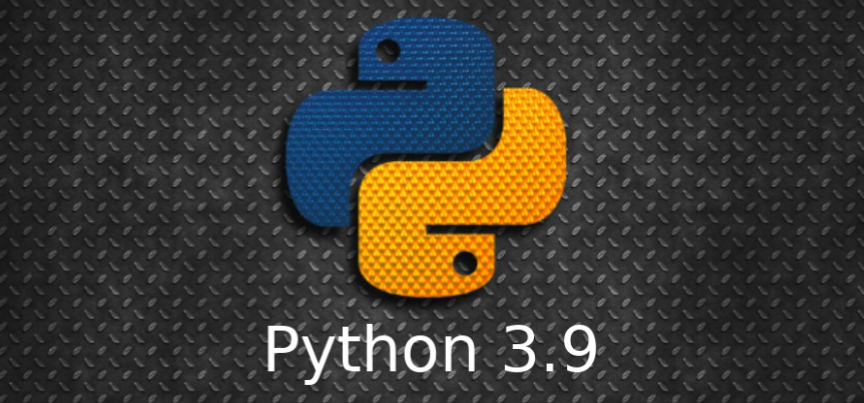Python 3.9 is here!
“
It takes about 3 minutes to read this article.
”
Python 3.9 is here!
In the past year, developers from all over the world have been working on improvements to Python3.8. The Python 3.9 beta version has been around for a while, and the first official version was released on October 5, 2020.
Every Python version contains new developments and improved features, and Python 3.9 is no exception.

Here are some major new features of Python 3.9.
1. Dictionary (merge & update) operator
The dictionary is one of the most basic data structures in Python, and with the iteration of the python version, the performance is continuously optimized.
In Python3.9, the merge (|) and update (|=) operators have been added to the dict class. These updates complete the existing dict.update and {** d1, ** d2} methods.
The traditional method of merging dictionaries:
>>> pycon ={2016:"Portland",2018:"Cleveland"} #Dictionary 1>>> europython ={2017:"Rimini",2018:"Edinburgh",2019:"Basel"} #Dictionary 2
# method one
>>>{**pycon,**europython}{2016:'Portland',2018:'Edinburgh',2017:'Rimini',2019:'Basel'}
# Method Two
>>> merged = pycon.copy()>>>for key, value in europython.items():... merged[key]= value
...>>> merged
{2016:' Portland',2018:'Edinburgh',2017:'Rimini',2019:'Basel'}
Both of these methods incorporate dictionaries without changing the original data. Please note that "Cleveland" in dictionary 1 has been overwritten by "Edinburgh" in merged dictionary 2.
You can also update dictionary 1:
>>> pycon.update(europython)>>> pycon
{2016:' Portland',2018:'Edinburgh',2017:'Rimini',2019:'Basel'}
The new version of Python introduces two new dictionary operators: merge (|) and update (|=). You can use | to merge two dictionaries, while |= is used to update the dictionary:
>>> pycon ={2016:"Portland",2018:"Cleveland"}>>> europython ={2017:"Rimini",2018:"Edinburgh",2019:"Basel"}>>> pycon | europython #merge
{2016:' Portland',2018:'Edinburgh',2017:'Rimini',2019:'Basel'}>>> pycon |= europython #Update
>>> pycon
{2016:' Portland',2018:'Edinburgh',2017:'Rimini',2019:'Basel'}
d1|d2 and {** d1, ** d2} have similar functions. Both are used to merge dictionaries and take the union. When the same key is encountered, the latter will overwrite the former.
One of the advantages of using | is that it is suitable for dictionary-like types and keeps the original type after merging:
>>> from collections import defaultdict
>>> europe =defaultdict(lambda:"",{"Norway":"Oslo","Spain":"Madrid"})>>> africa =defaultdict(lambda:"",{"Egypt":"Cairo","Zimbabwe":"Harare"})>>> europe | africa
defaultdict(<function<lambda> at 0x7f0cb42a6700>,{'Norway':'Oslo','Spain':'Madrid','Egypt':'Cairo','Zimbabwe':'Harare'})>>>{**europe,**africa}{'Norway':'Oslo','Spain':'Madrid','Egypt':'Cairo','Zimbabwe':'Harare'}
|= The role is to update the dictionary, similar to .update():
>>> libraries ={..."collections":"Container datatypes",..."math":"Mathematical functions",...}>>> libraries |={"zoneinfo":"IANA time zone support"}>>> libraries
{' collections':'Container datatypes','math':'Mathematical functions','zoneinfo':'IANA time zone support'}
|= You can also use a dictionary-like data structure for updates:
>>> libraries |=[("graphlib","Functionality for graph-like structures")]>>> libraries
{' collections':'Container datatypes','math':'Mathematical functions','zoneinfo':'IANA time zone support','graphlib':'Functionality for graph-like structures'}
2. Remove string prefix and suffix
In Python 3.9, you can use .removeprefix() and .removesuffix() to remove the beginning or end of a string, respectively:
>>>" three cool features in Python".removesuffix(" Python")'three cool features in'>>>"three cool features in Python".removeprefix("three ")'cool features in Python'>>>"three cool features in Python".removeprefix("Something else")'three cool features in Python'
Some people will say that the .strip method is also possible, but this method will be deleted by mistake:
>>>" three cool features in Python".strip(" Python")'ree cool features i'
As you can see, I obviously want to delete the ending word python, but the beginning there is also deleted part of -Th.
So .removeprefix() and .removesuffix() may be more accurate.
3. zoneinfo time zone module
zoneinfo is a newly introduced module in python3.9, zoneinfo can access the Internet Assigned Numbers Agency (IANA) time zone database. IANA updates its database several times a year, which is the most authoritative source of time zone information.
Using zoneinfo, you can obtain objects describing any time zone in the database:
>>> from zoneinfo import ZoneInfo
>>> ZoneInfo("America/Vancouver")
zoneinfo.ZoneInfo(key='America/Vancouver')
>>> from zoneinfo import ZoneInfo
>>> from datetime import datetime, timedelta
>>> # summer time
>>> dt =datetime(2020,10,31,12, tzinfo=ZoneInfo("America/Los_Angeles"))>>>print(dt)2020-10-3112:00:00-07:00>>> dt.tzname()'PDT'>>> #standard Time
>>> dt +=timedelta(days=7)>>>print(dt)2020-11-0712:00:00-08:00>>>print(dt.tzname())
PST
4. Built-in collection types are used for type hints
In type hinting, you can now use the built-in collection types (such as list and dict) as generic types without having to import the corresponding uppercase types (such as List or Dict) from typing.
def greet_all(names: list[str])-> None:for name in names:print("Hello", name)
5. Topological sort
Python 3.9 adds a new module, graphlib, which contains the graphlib.TopologicalSorter class to provide functions for performing topological sorting.
>>> dependencies ={..."realpython-reader":{"feedparser","html2text"},..."feedparser":{"sgmllib3k"},...}...>>>from graphlib import TopologicalSorter
>>> ts =TopologicalSorter(dependencies)>>>list(ts.static_order())['html2text','sgmllib3k','feedparser','realpython-reader']
6. Least Common Multiple (LCM)
Python has long been used to calculate the greatest common divisor (GCD) function of two numbers:
>>> import math
>>> math.gcd(49,14)7
The least common multiple (LCM) is related to the greatest common divisor (GCD). LCM can be defined according to GCD:
>>> def lcm(num1, num2):...if num1 == num2 ==0:...return0...return num1 * num2 // math.gcd(num1, num2)...>>>lcm(49,14)98
In Python 3.9, you no longer need to define your own LCM function, it adds the function of calculating the least common multiple:
>>> import math
>>> math.lcm(49,14)98
7. A more powerful Python parser
One of the coolest features of Python 3.9 is a feature that you don't notice in daily programming, and that is the update of the parser. The parser is the basic component of the Python interpreter. In the latest version, the parser has been rebuilt.
Python has previously used the LL(1) parser to parse source code into a parse tree. You can think of the LL(1) parser as a parser that reads one character at a time and interprets the source code without backtracking.
The new interpreter is based on PEG (parsing expression grammar), not LL(1). The performance of the new parser is comparable to that of the old parser. PEG is more flexible than LL(1) when designing new language functions.
In the entire standard library, the PEG parser is slightly faster, but it also uses more memory. In fact, when using a new parser, it is difficult to perceive the performance.
Reference: realpython, python documentation
Recommended reading
1
[ Why doesn't Python support the switch statement? ](http://mp.weixin.qq.com/s?__biz=MzIzNzA4NDk3Nw==&mid=2457741065&idx=2&sn=2a44ea68909191d695bb4b018e2df947&chksm=ff448f57c8330641262bf5155c2fa04946d88d163099d778redirecta69d2abf5155c2fa04946d88d163099d#
2
[ Linux! Why did he write such a strong system alone, but China can't do it? ](http://mp.weixin.qq.com/s?__biz=MzIzNzA4NDk3Nw==&mid=2457741059&idx=1&sn=db9004aa4d26a165a9a55dc0542b221a&chksm=ff448f5dc833064b52ff88988562a111aff833064b52ff88988562a111aff3909b89326e776edirect
3
Wonderful tricks: copy the text of the server to the local computer in ssh
4
[ Super complete! I have sorted out 200 standard libraries of Python](http://mp.weixin.qq.com/s?__biz=MzIzNzA4NDk3Nw==&mid=2457741042&idx=1&sn=5c25ce6562e1611691d59499c8db3a89&chksm=ff78eaccenebc26df78eacc8317130f3dscene26dv78eacc83e5146f3dscene#96f8d
Recommended Posts